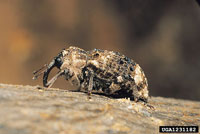Cryptoryhynchus lapathi
Hosts
Alder birch, Poplar, White birch and Willow
Appearance and Life Cycle

Photo credit: Gyorgy Csoka, Hungary Forest Research Institute, forestpests.org
Adults are stout weevils 8-10 millimetres (mm) long, with long curved snouts. Most of the body is covered with blackish scales, but the posterior end has an irregular band of pinkish or creamy-white scales. They have functional wings but rarely fly. Adults emerge in the spring and feed on the phloem of young shoots by inserting their mouthparts into the bark. During the summer, females chew holes into young bark on the lower part of the stems, and deposit white eggs, singly or in groups of 2 to 4. Larvae hatching from the eggs are C-shaped, white, legless and about 13 mm long at maturity. Larvae bore into the bark and move upwards through the wood, creating a series of meandering tunnels. Boring dust is pushed to the outside of the stem. Pupation takes place in the upper end of the tunnel behind a plug of wood chips.
Damage

Photo credit: Whitney Cranshaw, Colorado State University
Extensive tunneling by larvae causes severe weakening of tree limbs and trunks, making them susceptible to breakage during high winds or ice storms. Damage is indicated by fading foliage, broken, dead or dying limbs, and dead patches of bark that are often cracked open and oozing sap at points of attack.
Control
No pesticides are currently registered for the control of this borer. Few naturally occurring parasites and predators are known. Infestations can be reduced by removing and burning all infested wood before May or June, preventing larvae from maturing. If only a few trees are affected, the larvae can be destroyed by probing the tunnels with flexible wire.